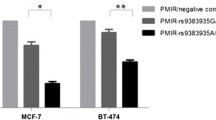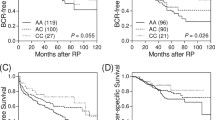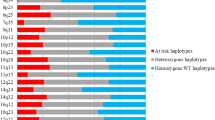Abstract
Ultraconserved elements (UCEs) are the most extreme representatives of conserved non-coding sequences. Recent studies have indicated that UCEs are not mutation cold regions and likely to be concerned with cancers, including breast cancer (BC). In this study, we first screened common single-nucleotide polymorphisms (SNPs) (minor allele frequency, MAF > 0.05) in Chinese population located in 481 UCEs sequences and selected seven SNPs (rs17049105, rs13020355, rs2682406, rs2056116, rs11190870, rs9572903, and rs8004379) of uc.51, uc.82, uc.133, uc.140, uc.302, uc.353, and uc.368, respectively. A two-stage case–control study of BC with a total of 1,497 cases and 1,497 controls in Chinese population was conducted to test the hypothesis that these SNPs of UCEs are associated with BC risk. Stage I with 735 cases and 735 controls was designed to discover the risk variants, followed by stage II with 762 cases and 762 controls to validate the significant variants. In stage I, although the genotype distributions of all seven SNPs were not significantly different between BC cases and controls, logistic regression analyses revealed that the variant genotypes of rs8004379 were significantly associated with the increased risk of BC (dominant model: adjusted OR = 1.27, 95% CI = 1.01–1.58, P = 0.039). We then selected two SNPs, rs8004379 A/C and rs2056116 A/G, with lowest P values of the associations into the stage II analysis. However, none of above two SNPs were significantly associated with BC risk in both stage II and pooled set (rs8004379 AC/CC vs. AA: adjusted OR = 0.88, 95% CI = 0.68–1.13 for stage II and adjusted OR = 1.09, 95% CI = 0.92–1.29 for the pooled set; rs2056116 AG/GG vs. AA: adjusted OR = 1.12, 95% CI = 0.87–1.45 for stage II and adjusted OR = 1.11, 95% CI = 0.94–1.31 for the pooled set). These findings did not support a significant association between UCEs SNPs and the risk of BC in Chinese population.
Similar content being viewed by others
Abbreviations
- UCEs:
-
Ultraconserved elements
- ER:
-
Estrogen receptor
- PR:
-
Progesterone receptor
- OR:
-
Odds-ratio
- CI:
-
Confidence interval
References
Parkin DM, Fernandez LM (2006) Use of statistics to assess the global burden of breast cancer. Breast J 12(1):S70–S80
Kelsey JL, Gammon MD (1991) The epidemiology of breast cancer. CA Cancer J Clin 41(3):146–165
McPherson K, Steel CM, Dixon JM (2000) ABC of breast diseases. Breast cancer—epidemiology, risk factors, and genetics. BMJ 321(7261):624–628
Bray F, McCarron P, Parkin DM (2004) The changing global patterns of female breast cancer incidence and mortality. Breast Cancer Res 6(6):229–239
Chen YC, Hunter DJ (2005) Molecular epidemiology of cancer. CA Cancer J Clin 55(1):45–54 quiz 57
Bejerano G, Pheasant M, Makunin I, Stephen S, Kent WJ, Mattick JS, Haussler D (2004) Ultraconserved elements in the human genome. Science 304(5675):1321–1325
Baira E, Greshock J, Coukos G, Zhang L (2008) Ultraconserved elements: genomics, function and disease. RNA Biol 5(3):132–134
Bottani A, Chelly J, de Brouwer AP, Pardo B, Barker M, Capra V, Bartoloni L, Antonarakis SE, Conrad B (2007) Sequence variation in ultraconserved and highly conserved elements does not cause X-linked mental retardation. Am J Med Genet A 143A(8):888–890
Lareau LF, Inada M, Green RE, Wengrod JC, Brenner SE (2007) Unproductive splicing of SR genes associated with highly conserved and ultraconserved DNA elements. Nature 446(7138):926–929
Calin GA, Liu CG, Ferracin M, Hyslop T, Spizzo R, Sevignani C, Fabbri M, Cimmino A, Lee EJ, Wojcik SE et al (2007) Ultraconserved regions encoding ncRNAs are altered in human leukemias and carcinomas. Cancer Cell 12(3):215–229
Rossi S, Sevignani C, Nnadi SC, Siracusa LD, Calin GA (2008) Cancer-associated genomic regions (CAGRs) and noncoding RNAs: bioinformatics and therapeutic implications. Mamm Genome 19(7–8):526–540
Wojcik SE, Rossi S, Shimizu M, Nicoloso MS, Cimmino A, Alder H, Herlea V, Rassenti LZ, Rai KR, Kipps TJ et al (2010) Non-coding RNA sequence variations in human chronic lymphocytic leukemia and colorectal cancer. Carcinogenesis 31(2):208–215
Yang R, Frank B, Hemminki K, Bartram CR, Wappenschmidt B, Sutter C, Kiechle M, Bugert P, Schmutzler RK, Arnold N et al (2008) SNPs in ultraconserved elements and familial breast cancer risk. Carcinogenesis 29(2):351–355
Pennacchio LA, Ahituv N, Moses AM, Prabhakar S, Nobrega MA, Shoukry M, Minovitsky S, Dubchak I, Holt A, Lewis KD et al (2006) In vivo enhancer analysis of human conserved non-coding sequences. Nature 444(7118):499–502
Paparidis Z, Abbasi AA, Malik S, Goode DK, Callaway H, Elgar G, deGraaff E, Lopez-Rios J, Zeller R, Grzeschik KH (2007) Ultraconserved non-coding sequence element controls a subset of spatiotemporal GLI3 expression. Dev Growth Differ 49(6):543–553
Ni JZ, Grate L, Donohue JP, Preston C, Nobida N, O’Brien G, Shiue L, Clark TA, Blume JE, Ares M Jr (2007) Ultraconserved elements are associated with homeostatic control of splicing regulators by alternative splicing and nonsense-mediated decay. Genes Dev 21(6):708–718
Bernstein BE, Mikkelsen TS, Xie X, Kamal M, Huebert DJ, Cuff J, Fry B, Meissner A, Wernig M, Plath K et al (2006) A bivalent chromatin structure marks key developmental genes in embryonic stem cells. Cell 125(2):315–326
Lee TI, Jenner RG, Boyer LA, Guenther MG, Levine SS, Kumar RM, Chevalier B, Johnstone SE, Cole MF, Isono K et al (2006) Control of developmental regulators by Polycomb in human embryonic stem cells. Cell 125(2):301–313
Feng J, Bi C, Clark BS, Mady R, Shah P, Kohtz JD (2006) The Evf-2 noncoding RNA is transcribed from the Dlx-5/6 ultraconserved region and functions as a Dlx-2 transcriptional coactivator. Genes Dev 20(11):1470–1484
Catucci I, Verderio P, Pizzamiglio S, Manoukian S, Peissel B, Barile M, Tizzoni L, Bernard L, Ravagnani F, Galastri L et al (2009) SNPs in ultraconserved elements and familial breast cancer risk. Carcinogenesis 30(3):544–545 author reply 546
Author information
Authors and Affiliations
Corresponding author
Additional information
Hao Shen and Cheng Lu contributed equally to this work.
Rights and permissions
About this article
Cite this article
Shen, H., Lu, C., Jiang, Y. et al. Genetic variants in ultraconserved elements and risk of breast cancer in Chinese population. Breast Cancer Res Treat 128, 855–861 (2011). https://doi.org/10.1007/s10549-011-1395-4
Received:
Accepted:
Published:
Issue Date:
DOI: https://doi.org/10.1007/s10549-011-1395-4




